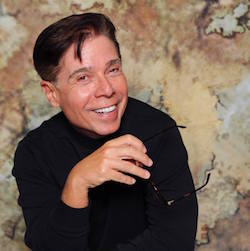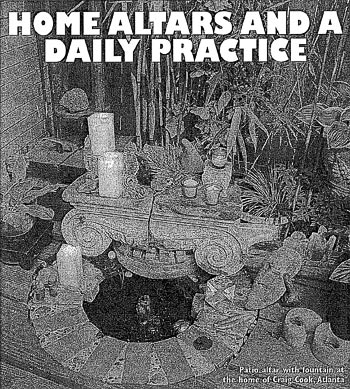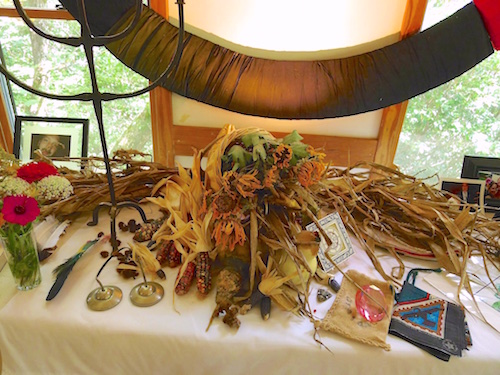This is the third in a series of articles about altars republished from the Visionary archives. It was originally published in the Summer 2001 issue of GSV’s Visionary journal.
Altar Building Rediscovered
By Cami Delgado

The ancient art of altar building has made a comeback and it’s no wonder. Altars nurture and uplift our souls, support prayer and meditation and remind us of an invisible world we can’t see.
Building an altar can be a creative, energizing, and affirming experience that celebrates you and everyone who has enriched your journey. In your living room, it creates an atmosphere for soulful sharing. In your bedroom, it accentuates the sacredness of lovemaking.
Be bold and juxtapose contrasting power objects. On my altar, Quan Yin, shamanic rattles, Merlin the magician, an Om symbol, ceremonial feathers, sacred bells, a Celtic urn, and Jesus, all live harmoniously and celebrate the diversity of my spiritual sources.
Bring nature into your altar by including stones, minerals, sea shells, and live plants. Call forth the cleansing power of water by having water from a very special ocean, lake, river or spring, in a sacred vessel and let this natural element speak to your soul. Elicit Earth energy by collecting sand or earth from a favorite sacred site and keep it in a sacred container. Personalize your altar by honoring special beings who have inspired you, walked the journey with you or enriched your inner life. Images or quotes from your favorite spiritual mentors, elders, and teachers add inspiration. Particularly honor special gay men whose presence or written word have inspired you along your path.
An altar that celebrates all that you are would include a celebration of your gayness and sexuality. My altar includes rainbow flags and pink triangles. I’m still searching for a self-standing phallus. [pullquote align=”left” cite=”” link=”” color=”” class=”” size=””]Others honor a loved one by placing his pubic hair in a sacred pouch. [/pullquote]
Images of the naked male body placed amidst sacred objects speak to the harmonious integration of spirit and body. Others honor a loved one by placing his pubic hair in a sacred pouch.
Enhance the self-expressive character of your altar by creating special objects you have made. Hand painting spiritual symbols onto rock, fabric, candles or wood is a way of creating your own personalized and unique sacred objects.
My altar also includes the goddess Psyche (I’m a psychotherapist), Chinese Foo Dogs, Native American medicine beads, Greek Orthodox icons, Buddhas, yin yang symbols, a spiritual colonial Mexican painting,Tibetan and Hindu mala beads, sacred stones, I Ching coins, two plants, a rain stick, a Kabbala tree of life, an African goddess, a Lalique angel, 14 candles, my country’s coat of arms, and other personally meaningful items. It mirrors, expresses and supports essential aspects of my inner world.
These ideas awaken your intuition and inspiration. Let your altar be a genuine expression and celebration of your soul’s richness. Use the gift of your imagination to create a visual reminder of the potential that lies within you and of the sacredness of being gay!
Do it joyously!
This article was originally published in the Summer 2001 issue of GSV’s Visionary journal. Read the original article in that issue of Visionary.


 My daily practice is Yoga, breathing, Chi Gung, meditation and Planetary Acupuncture. Decades ago I studied Yoga with the Pierce Program in Atlanta with Martin Pierce’s first Men’s Class. Then for several years I attended a “Wellness Workout” taught by Jean Dunham that combined breathing, stretching, Skinner Releasing and dancing. Here I was also introduced to the Tao Animal Exercises in which you “become” different animals to energize different body systems.
My daily practice is Yoga, breathing, Chi Gung, meditation and Planetary Acupuncture. Decades ago I studied Yoga with the Pierce Program in Atlanta with Martin Pierce’s first Men’s Class. Then for several years I attended a “Wellness Workout” taught by Jean Dunham that combined breathing, stretching, Skinner Releasing and dancing. Here I was also introduced to the Tao Animal Exercises in which you “become” different animals to energize different body systems.


